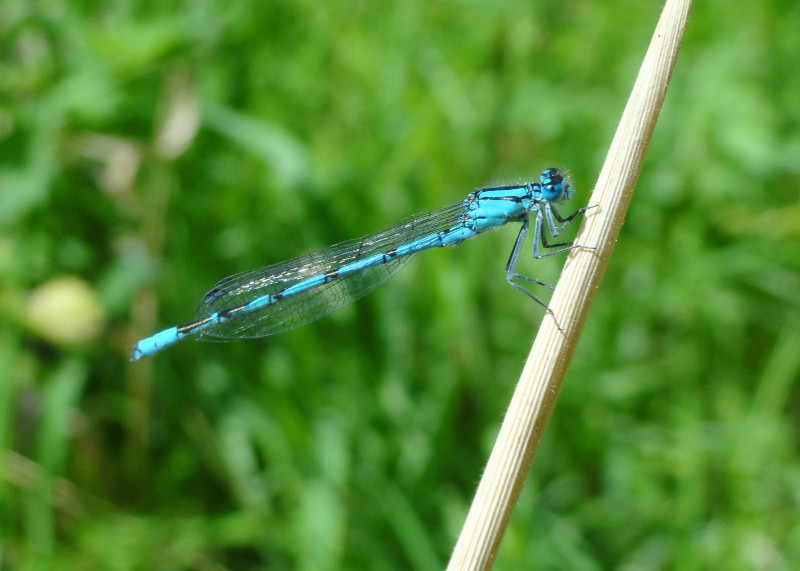
Powder Blue Damselfly Facts
- Most people who know of it refer to this dazzling product of Nature and evolution by the common name of the Powder Blue Damselfly. Yet, this marvel also has a few other general titles. These include such terms as common bluet, northern bluet, among many others.
- Scientific professionals, however, perhaps know the small wonder somewhat better by its techinical moniker. Unfortunately, that’s a difficult one for the layperson to pronounce. That’s because the beautiful Arthropod bears the formal epithet of Enallagma cyathigerum.
- The delicate creature received that appellation due to the efforts of Toussaint von Charpentier. The acclaimed German entomologist accomplished the first acknowledgement of it as a separate and distinct species. He managed that scientifically noteworthy feat in 1840.
- It represents one of many species considered important to researchers studying human impact on the environment. Due to its specific nature and habitat, it presently serves as an important indicator of the relative health of certain specific types of ecosystems within its range.
- Thankfully, the Powder Blue Damselfly appears to be maintaining a population base that’s both stable and sufficient. That pleasant state also seems to hold true across the entirety of its range. The IUCN therefore currently lists the insect as Least Concern on its published Red List.
- The wonder of evolution nonetheless faces many potential threats to its continued existence as a species. Like all forms of life on this planet, most of these stem from the actions of man. These dangers include the dual perils posed by both habitat loss and climate change.
Related Articles
Red Veined Darter
Powder Blue Damselfly Physical Description
The visually stunning Powder Blue Damselfly generally captivates those individuals fortunate enough to notice one of the lovely creatures. Unlike some of its kindred, though, it does no do so due to size. That’s true given the fact that it ranks as somewhat smaller than some of them.
It does follow one pattern of development common to the group, though. That’s in the fact that it displays a certain degree of the physiological characteristic of sexual dimorphism. In its specific case, however, this trait only manifests itself in terms of outward physical appearance.
Regarding dimensions, both genders of the wonder attain the same overall measurements. Among mature adults, this ranges from approximately 1.3 – 1.4 in (3.2 – 3.5 cm). Exceptional individual do occur, of course, regardless of sex. Yet, few of these exceed thus length by any great amount.
It also sets itself apart from all other closely related damselflies in one particular aspect. That’s due to the fact that the side of its thorax presents a single black stripe. In all other close kindred, two such features appear in this location. It also displays a spot between thorax sections others lack.
But, it’s the gorgeous patterns of color of the mesmerizing Powder Blue Damselfly that most viewers most notice and appreciate. This aspect is also where the two genders separate themselves. The males almost exclusively present an overall cerulean blue shade, with some black markings.
Females of the species, though, manifest a markedly wider variety of base colors, shades, and even patterns than their male counterparts. Other colors occasionally presented include greenish-brown or brown. Some examples further separate from the males by showing more black features.
- Kingdom: Animalia
- Phylum: Arthropoda
- Class: Insecta
- Order: Odonata
- Family: Coenagrionidae
- Genus: Enallagma
- Species: E. cyathigerum
Powder Blue Damselfly Distribution, Habitat, and Ecology
The breathtaking Powder Blue Damselfly evolved as endemic to an extremely broad swathe of the surface of the earth. Impressively, the full extent of that native zone of habitation may surprise many people, though. This insect dwells in most of two of earth’s eight biogeographical regions.
In North America, the species inhabits virtually all of both Canada and the United States. In Mexico, its range reaches into the northern areas. Yet, this intrepid insect also resides across much of Europe, including in Sweden and Norway. In Asia, meanwhile, it also appears in South Korea.
This spectacular small marvel displays decidedly clear preferences regarding its choice of habitat. The nature of these, though, do leave the creature somewhat vulnerable to local changes in its immediate environment. These appear in various places, though, including forests and parks.
It generally lives either on or in very close proximity to small bodies of water. While their conditions vary, each of these must meet certain criteria. Each must be relatively shallow and slow moving. These even include patches of weeds in ditches, wadis, and oases, or small, still streams.
The Powder Blue Damselfly feeds as a carnivore. The vast majority of its diet is comprised of the types on small insects that usually frequent its own preferred ecosystem. That prey mainly includes flies, mosquitoes, and aquatic insects. Yet, it also eats larger fare, such as bees and moths.
Its larvae emerge as adults between May and August. The Arthropod focuses on feeding for only a short time, however, before inevitably turning its attention to mating. Many species feed on both the young and adults, though. These multiple predators include fish, birds, frogs, and water spiders.
Species Sharing Its Range
Check out our other articles on 7 Magnificent West Coast Marvels, Striped Skunk, Orinoco River, Spinetail mobula, Fire Salamander, Indian Vulture, Small Copper, Alligator Snapping Turtle
